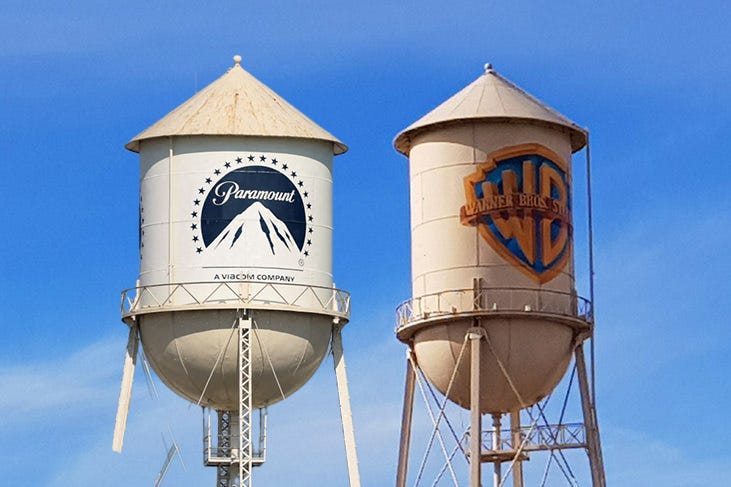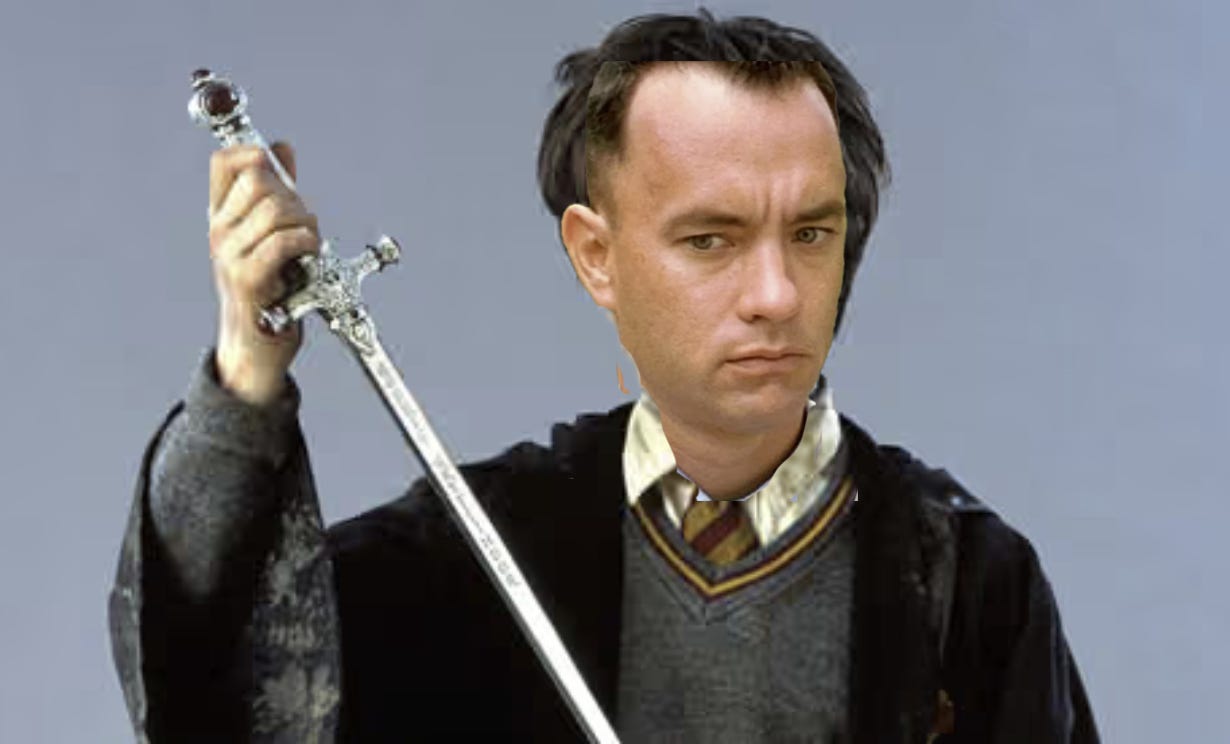David Ellison has a lot of room to create a world to his specs on Melrose… so why does he feel the need to draw all over Barham?
It’s been almost a month since did the first part of this story, focusing on the theatrical disaster that a Paramount/WBD merger would likely create for that part of the industry.
There has been a lot more water under the Ellison bridge since then… so much so that it has kind of frozen me from proceeding with this part 2, as the data keeps flying in. The latest piece of the barely-started puzzle is a push in the last few days by Team Ellison to position a merger with WBD that was floated a few weeks ago is nearly a fait accompli. Rick Ellis does a nice job of laying out the media laying down on this story.
One of the major problems with the current entertainment (and other) media is that we still live in a world in which we believe sources are somehow compelled to be honest. Moreover, that there are serious legal ramifications for public companies lying to the press behind a wall of anonymity. There are, indeed, laws about business interference… but they are almost never engaged because if you are in court on something like that, you are likely already dead in the industry water. And of course, on the media side, they now give anyone who wants anonymity anonymity, meaning that sources are protected, whether they mislead or not. We also live in the era of overwriting or outright disappearing our journalistic mistakes.
Then you have the con men like Rich “Always Wrong” Greenfield who are more interested in being media personalities than being smart… because people don’t know what smart is anymore. Insight is measured by aural volume, not by facts and the history of facts. (I should full disclose… Rich was right about Netflix stock value and rides that like Slim Pickens at the end of Dr Strangelove every day of his professional life.)
But I digress…
The simplest reality on Paramount/Warner Bros Discovery is that is about as horizontal a merger as you could create. When, for a moment, Warner Bros Discovery was exploring some kind of deal with the Redstone Paramount, it was focused mostly on the one asset that Paramount had/has that WBD does not…a. broadcast network. When Disney picked up the parts of Fox it picked up, they created a much stronger TV production group and a library for streaming when its library was relatively sparse.
What element would Ellison Paramount add to its portfolio by acquiring WBD? (crickets)
Yes, the Paramount TV production business, which once rivaled Warners and surpassed Sony has been in the relative toilet for a while now. So WBD would strengthen that asset. So a marginal improvement.
But Streaming? Are you kidding? HBO Max and Paramount+ are what they are. All of the, shall I say, idiots, who are talking about how you just add the number of subs from each and voila!, you have double the subs, are the same people who have been bitching and moaning about HBO content being soiled by Discovery content for years now. They’ve also been whining about the weakness of both platforms for years… but put them together and people who don’t like chocolate and people who don’t like peanut better are all instant Reese’s Peanut Butter Cup fans.
Merged or separate, these two platforms cannot ever be Netflix, which is a very different model for now, or Disney, which has the unique proposition of owning a big chunk of the family space even with a relatively small library of those titles. And now, Disney has built out ESPN, which is in its infancy as a platform, as another dominant enterprise, based on sports rights. (ESPN: The App is currently held back by the fight to keep cable/satellite/virtual cable alive and generating more per-customer revenue than DTC has. Another complex conversation.)
HBO has been returned to the top of the Max branding… but that is still a positioning effort, not an accelerant. And Paramount Mountain remains, I think, the worst television branding campaign in history. The normally intelligent folks on Melrose convinced themselves that they could make Paramount into Disney… we have Star Trek AND Spongebob, RuPaul AND Yellowstone. They kinda missed the fact that Disney has been silo-ing content within the Disney brand for over a decade and that they don’t try to sell DTC by putting Tinkerbell on Captain Jack’s pirate ship or making Mickey an Avenger.
I have been saying this forever, but… sell your shit first! Put the oxygen mask securely over your mouth before you start to help other people with theirs.
We don’t know - and in this I include David Ellison and all the many veterans smarties he has brought into the fold over there - whether Ellison’s Paramount is going to be successful in its ambitions at any or all levels. They have afforded themselves the opportunity to do virtually anything. Success or Failure and all the gray zones in between are in the doing, not in theories run up the flagpole.
And class… class!!!… what happens when companies merge and take on debt loads close to their own value as a company to do so? They SHRINK!!! They have to.
Ellison bought Paramount in all of its glory for what seems like a pretty cheap price for a movie studio in 2025, with Netflix valued at over $500 billion and Disney valued at over $200 billion. And still, with all the money in his family, what is the first thing on the table? Firing people.
So what happens if you push together Paramount+ and HBO Max? Well, of course you fire people. A lot of people. But getting over that human tragedy, the next thing you do is come up with a focused programming strategy. What is this thing “we” are selling? Let’s assume they escape Paramount Mountain. WBD has determined that HBO is the most important brand for them, even though the audience levels are not blockbuster, because it is quality.
What IS Paramount+? What would ParaBros be?
When I go to Paramount+, the “Now Featuring” block leads with an Ozzy Osbourne doc, Tony & Ziva, Tulsa King, Red Alert, We Will Dance Again, The Amazing Race, Survivor, Reunion, The Daily Show, The Naked Gun, and Smurfs.
Who is this channel for???
For what it’s worth, 7 of the 10 “Top 10 Shows Now” listed are from Paramount’s linear asset base, with only Tulsa King, Tony & Ziva, and the spin-off from CBS, Criminal Minds Evolution, finding Top 10 viewership on the app.
Head over to the HBO MAX app and the Top 10 Series is 2 HBO series, 2 HBO Max originals, and 6 shows from the Discovery portfolio (TLC/ID/Food Network).
Mix those 2 platforms together and you get a lovely WHAT THE FUCK salad.
This, of course, is oversimplifying. There would have to be some unifying vision from someone if there was a merger. Right? Maybe they can hand it all to a tv critic with no experience in the industry aside from offering opinions. Ha ha. That would never happen! (Ha ha. It has in news!)
HBO Max also has a Top 10 Movies section… 3 titles released in the last year and 7 from the aging library, almost all of them more than a decade old. Paramount+’s Movie Top 10 is similar, the top 3 being new-ish and the other 7 being old… only 2 of which are from the Paramount library, the rest from Sony and Disney/Fox.
If I go to these platforms, I can see what is there. But what is it that drives me to go there? My position on being a successful platform with limited churn has been - and continues to be until something suggests otherwise - a paying subscriber needs to have a reason to click on the app on their TV (or other device) 6 or 7 times a week, finding 4 or 5 things they actually want to watch.
In my household, Paramount+, Peacock, and Hulu earn their place because my wife watched broadcast programming without commercials on all 3 every week. She sometimes watches Original Programming on these platforms. But the core value for her is the “repeats.” And that is enough. (The fact that I watch TV professionally is a separate matter.) But not everyone has that tendency and the pricing continues to drive people away from ad-free subscriptions, though more slowly than most anticipated.
HBO Max, in this household, is anchored by Oliver and Maher (him less for me, lately) and the steady stream of quality Original Programming, that often creates an additional weekly stop… and all of it commercial free. (We have fiber optic internet service via AT&T, which offers a “free” ad-free subscription as part of the package. Any merger might disrupt this, which is yet another variable.)
My family platform choices (which include Criterion Channel and Crunchyroll as well), are not all that relevant. But my point is that there are so many variations of what families and singles are looking for from their home entertainment choices. I really enjoy a lot of the Amazon Prime content, but their platform’s old-world bazaar feel - this is free, this cost money, this is another channel, this is available but only with commercials, etc - enrages me on a regular basis. Netflix is the deepest well, but for whatever reasons, the others in my family rarely dip in. I am a complete FX nerd and rarely watch the Disney+ side… but Hulu is pretty much a daily stop. If AppleTV+ ended, I would be very unhappy… lots of shows I have really loved and a bunch I ignore.
The point, again, is that the best thing is to have everything available. But that is, with just the 7 “top” channels, a proposition too expensive for most households in America, much less the world. More so without ads. And then, on top of that, I want local stations and news… which with YouTubeTV or Hulu LiveTV means another $80 on top of all that. And our fiber optic is $90 - $100 a month. There is no going back, but it makes the “old days” look pretty affordable at this point.
If Ellison could get $45 a month for Paramount Bros Streaming and maintain the sub count at, say, 70 million domestic and 70 million international as a starting place, a merger like this would make sense. But that would mean that the combined operation would generate 50% more than Netflix does today. In other worse, a fantasy.
Worse, even half that price point and revenue - $22.5 a month - is still pretty unrealistic on price and overall revenue for this - or any, really - combination of existing platforms. That would be about where Disney now is on TV (linear and DTC), $34 billion a year, not including ESPN linear or DTC (another $16b a year).
Paramount is at about $24 billion a year on the TV side. They have sports rights, but no ESPN, which even in its current reduced version, is still a cash machine. Still, the goal for Paramount should be to build its TV business another $5 billion - $10 billion in the first 5 years of the Ellison regime… by improving the model, not by acquiring another company.
And by the way, although Paramount has not broken out some of the segments clearly for investor consumption, they seem to net less than half in TV what Disney does. So there is a lot of work to do.
I love the idea of Ellison modernizing the television delivery business in ways that I have yet to imagine, using the newest technology or just some great ideas. But being bigger is unlikely to change the bottom line in a meaningful way… and will force more shrinkage.
I believe in the better mousetrap. And maybe Ellison and his team can build one. But it’s not going to be the new AI. There is nothing indicating that Ellison can turn this very mature model into a fast riser all of a sudden. But they could do great work. Yay.
But even great work is a lot of hard work without explosive results. Welcome to Hollywood.
Meanwhile… the current paid subscriber count is helpful, but a bit blurry, as each of the companies has a different footprint across the globe. For instance, there is no HBO Max in Canada… but the content is available through CRAVE, a Bell Media company, which has fewer than 4 million subs.
Peacock - 41 million
AppleTV+ - 45 million
Paramount+ - 79 million (international subs unknown)
HBO Max - 125 million (split roughly in half, dom/int)
Amazon Prime - 205 million
Disney 207 million - D+ 128m/Hulu 56m / ESPN 24m (apprx 70m international)
Netflix - 300 million
The Merger argument is that the 4 Streamers under 200 million subs should somehow merge down to 2 or even 1 platform that could then compete with the current Top 3.
But you can’t just add the numbers. For one thing, the combined cost of the 2 Streamers for consumers would be the most expensive of the mainstream Streamers… that can’t work. Also, how many of the subscribers for each service overlap?
And even more significant, merging the companies does not mean they will produce a Streamers with all the content that both currently offer, much less the additional library content they don’t offer.
HBO Max is the largest of the smaller Streamers at this point. But the question remains, is the business a good investment? If you didn’t have another company to merge with it, would be it be a good investment? And if it is worth the investment, is merging it with “your” company actually weighing down the future of that investment?
I haven’t had the time here to discuss some of the other sticky wickets of this deal. But Part 3 will land.
Until tomorrow…






HBO non è presente nemmeno in Italia, comunque....